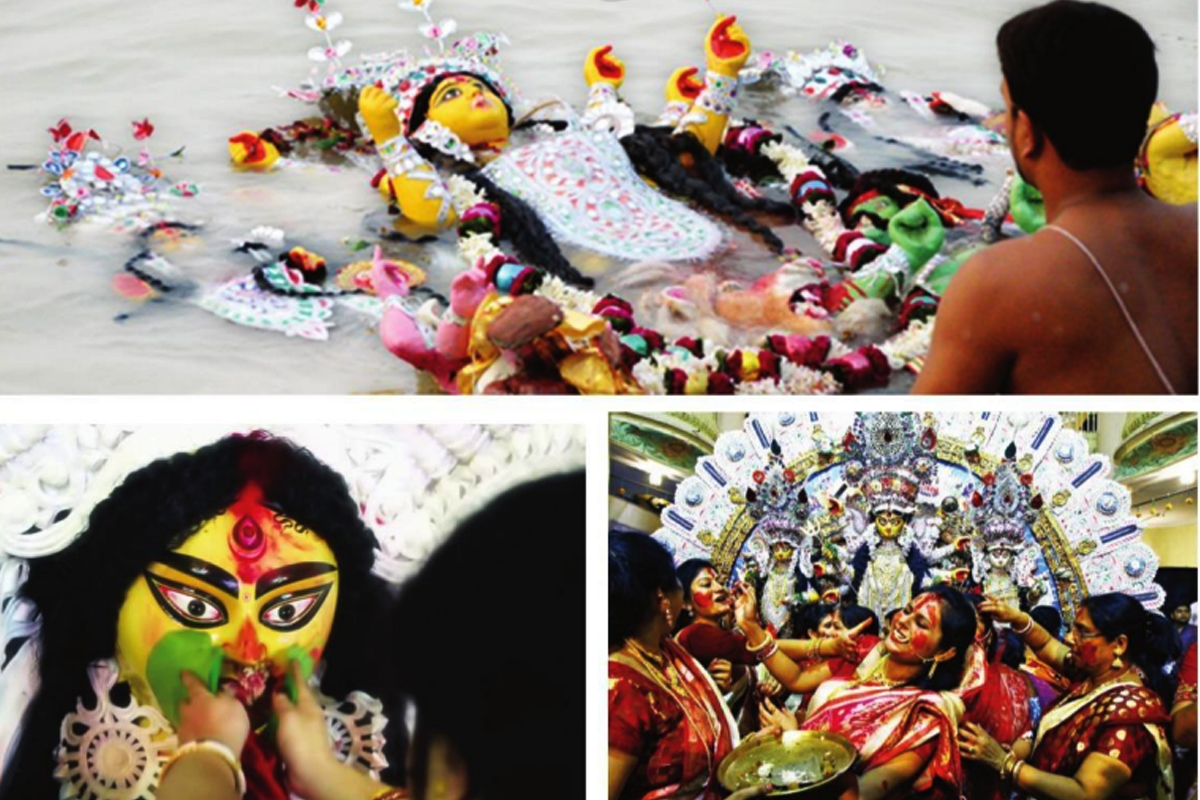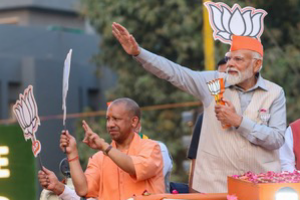Rethinking immersion: As the euphoria and exuberance of Durga Puja comes to an end, the time comes to say goodbye to the festive mood with a heavy heart. The fervour and trance subside, resulting in melancholy and a sullen state of mind. According to tradition, on the completion of 10 days, Devi Durga returns to Kailash from her maternal home.
It is certainly sorrowful to see exquisitely decorated and intricately carved idols being immersed into rivers.
The departure of Devi Durga amid the slogan “Ashche bochor abar hobe” signifies the eagerness of Bengalis for the next puja.
On the evening of Dashami, relatives and neighbours wish each other Shubho Bijoya and exchange gifts and sweets.
The younger members of households pay respect to their elders and ask for their blessings at family gatherings.
Although the immersion of the clay and terracotta idols in water bodies is an age-old custom, it is responsible for the pollution of water bodies as well.
The paint on the idols, comprising detrimental chemicals, is dissolved in water bodies, and ghats are full of mud and slushy water.
The people consuming water from these water bodies are exposed to these injurious chemicals, and often fall prey to dangerous diseases. Therefore, immersion of innumerable idols after every festival in water bodies should be regulated and restricted and a suitable alternative should be applied.
(Sumedha Das, Coordinator, Class XI, St Josephs Convent, Chandannagar)
An emotional farewell: Like all good things that come to an end, puja comes to an end, too. After the short celebration of five days, the idols are immersed into the water, marking the end of the festival that Bengalis long for throughout the year.
The saddest part is seeing the grand and gorgeous idols of Devi Durga being carried by a crowd of people to a nearby water body for immersion. Even before the day of Dashamibegins, one starts to get the feeling of emptiness immediately after the completion of “Sandhi Pujo”.
It surprises me to no end as to how these three days pass by, as if in a matter of nano seconds. Our eyes get swelled-up at the thought that Maa has gone back and another year of waiting has begun.
We ask for Her blessings as she begins her return journey with the thought of “Aasche bochor abar hobe”. Just as the dominance of good over evil is accepted by us, one should also realise that goodness also needs to be dominated by evil at some point of time, as this is the only way to strike a balance between good and evil.
Only when evil dominates the good do we realise its value and worth. Similarly, when pujo ends after five days, we start missing its essence and vibes throughout the year and eagerly wait for its arrival next year.
Good things do not last for too long so that we do not start underestimating the good times. One should learn to let good things go in one’s life with the same smile with which we bid adieu to Maa Durga and wait for her to come again.
(Soumi Mandal, Coordinator, Class XI, South Point High School)
Heartbreak for every Bengali: On the day of Panchami our joy knows no bounds, as Maa Durga reaches her paternal home after one long year. Just after four days, we celebrate Bijoya Dashami; it is a time when we have to mournfully accept the melancholic fact of Maa leaving.
Durga Puja: the word itself gives rise to an indescribable excitement in every Bengali’s heart. People, both young and old, become busy in shops, choosing exuberant attire even before the month of Ashwin begins.
Just as the night of Panchami is spent with great excitement, since the next day is Shashti, the night of Nabami is spent with utmost sadness because the next day is Dashami.
It is really hard to accept that the excitement of so many days will come to an end the following morning. When I was five years old, “sindur khela” used to attract me a lot. It was actually because, on that day, I could see my mother clad in her redbordered garad saree with the sindur (vermillion) shining brightly on her face. Eight years have passed since then, but still sindur khela is one of my favourite events during Durga Puja.
The mixed emotion that is noticed on every face makes this event very special to me. It seems to me as if Maa Durga mourns to leave her paternal home and go back to Kailash. Everyone gives silent sighs to accept the fact that Maa Durga will come to us again after one long year. After the “sindur khela” is over, the bhasan process begins. People enjoy dancing to the beats of dhak, but this enjoyment does not last long.
When the idol of Maa Durga is immersed into the Ganges, every person has a tear in their eye. It seems as if a daughter has left her paternal home after marriage. On the day of Dashami, Maa Durga no longer remains a powerful Goddess; instead, she becomes a member of our family whose absence makes our homes lonesome, the pandals silent and the air without flavour.
When everyone returns after the immersion with mournful faces, the same sound of the dhak, which gave rise to excitement four days ago, now gives rise to only one thought in our mind: “So, it has come to an end.”
The sadness of Bijoya, too, does not last long nowadays. As soon as the pandals are removed and our normal lives begin, no one has the time to remember Durga Puja. Only sometimes, in the middle of our busy schedules, when we come across few pictures we just smile, thinking of the happy memories.
Every year when Maa Durga arrives, she finds that almost everything has changed. She finds the best relation broken, best friends becoming enemies and the happiest person now morose. But still, she never refuses to come to us every year. Maa Durga accepts all changes and helps us accept them too.
(Titas Sengupta, Coordinator, Class VIII, St Josephs Convent, Chandannagar)
True essence of Bishorjon
Tears welled in the eyes; enshrouded vermillion visages, scrimmaging to touch her feet for the last time and bid her adieu as she peters out and mingles in the river waters, turned to sorrow. “Asche bachor abar hobe” – it’s Bijoya Dashami, an emotion.
As Durga Puja is welcomed with the unbridled verve of happiness, similar should be the Bishorjon.
During his days in Dakshineswar, Sri Ramkrishna Paramhansa had delineated the true connotation of immersion. In 1870, Mathuramohon Biswas, the son-in-law of Rani Rashmoni, had inaugurated Durga Puja.
After offering prayers and celebrations that filled the Janbazar Rajbari with tufts of glee, Mathur was not willing to sacrifice the good-ness. Engrossed and bitter with the aspect of “Bisorjon”, Sri Ramakrishna Dev had untangled the ultimate truth of Devi Durga’s sacrifice, then.
According to Ramakrishna Paramhansa, for three days we worship the Goddess in our courtyard; but her immersion never meant sacrificing her wholly for the rest of the year, but immersing her in our soul. For the rest of the year, Ma Durga will remain with us throughout, to lead and guide us through doubt.
(Aryika Ghosal, Coordinator, Class X, St Josephs Convent, Chandernagore)
A moment of emancipation: Starting from Mahalaya, we don’t waste a single second while celebrating and worshipping our beloved Ma Durga.
The main reason for making so many plans, having a list of so many pandals to visit and, most importantly, the whole adrenaline rush along with the grand lightings and sounds of dhakisis that it all comes to an end when dashami arrives.
It is a fact that all good things should always come in small measures; thus, even our most rejoiced festival, Durga Puja, comes to an end with Bishorjon.
It is not just a festival. It is that spiritual bond of unity whose threads intertwine us in mysterious ways and give us the true feeling of belonging to a single community.
However, Bishorjonis that part of puja where reality hits us. Watching the gradually immersing idol of Ma durga and witnessing the silence that prevails is a moment of pure sadness. But, it is believed that Ma Durga comes only to give us happiness and goes away carrying all of our burdens and pain with her.
Despite what people may believe, it cannot be denied that the moment Ma Durga’s idol is immersed an immense level of abandonment is felt because she is a protector, and thus the word Bishorjon also connotes abandonment. As the idol immerses in the water, almost all of us feel that tingling glistening in our eyes, which for some is tears and for others, redemption.
(Oindrila Gupta, Coordinator, Ex-St Joseph and Mary School)











